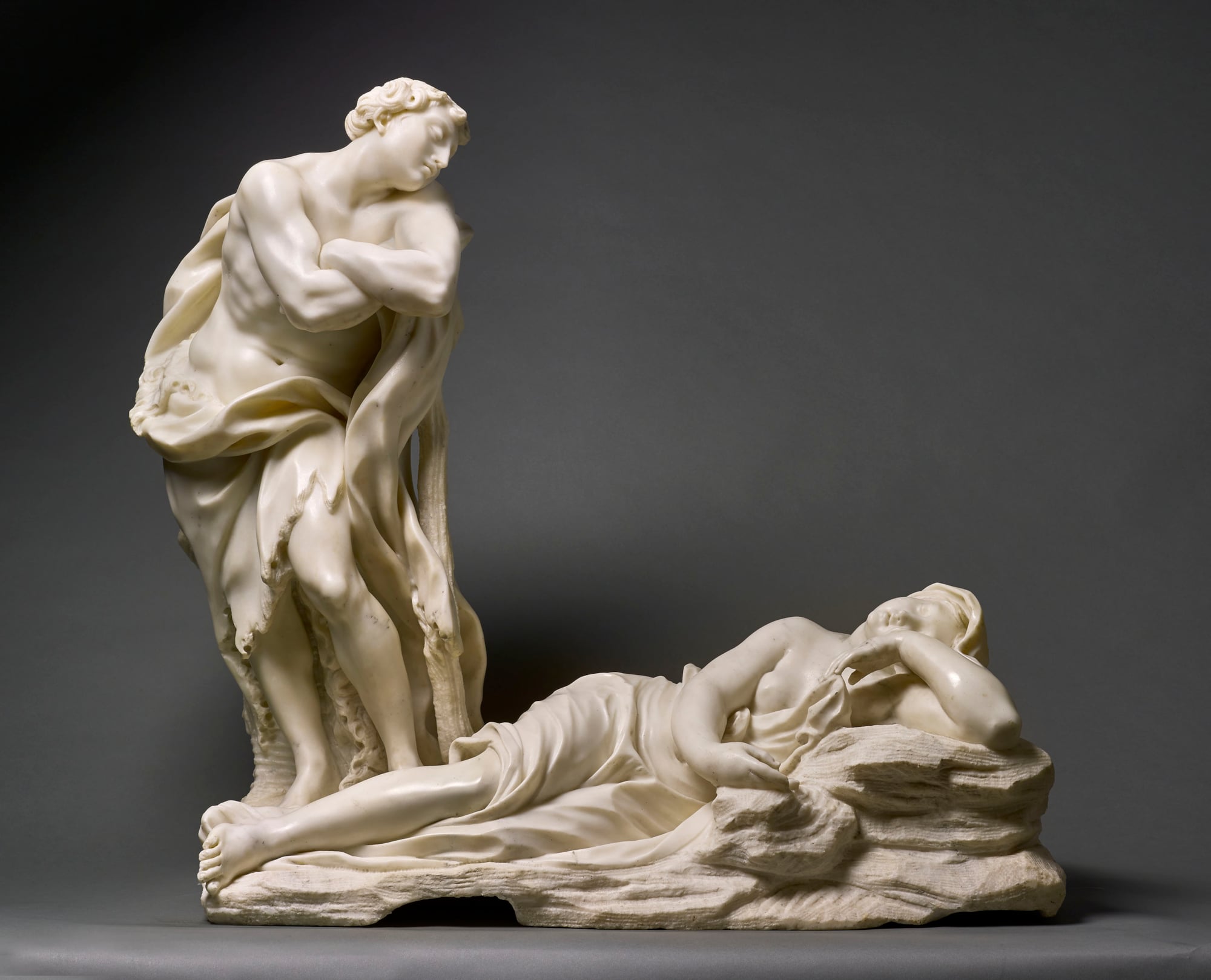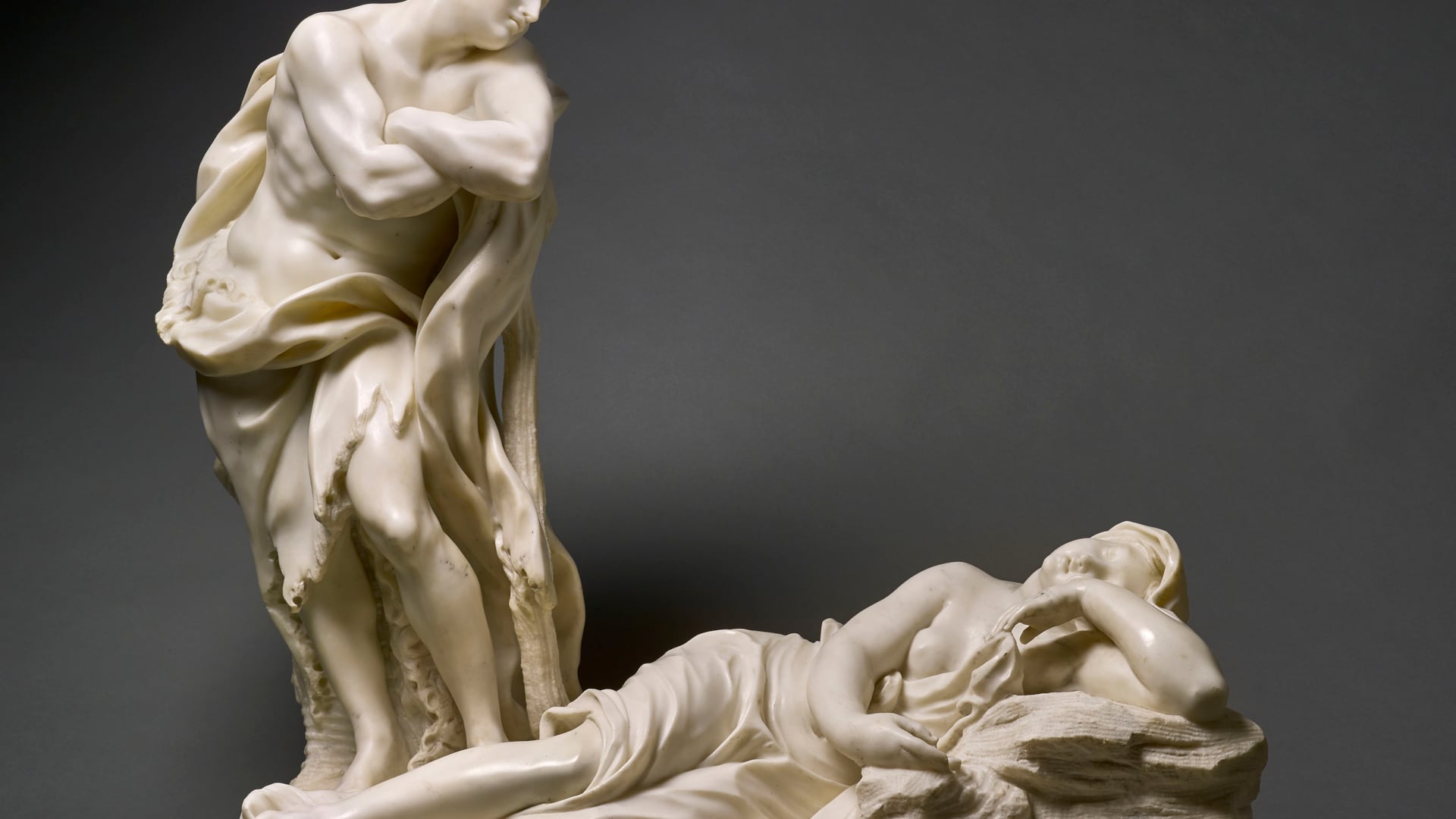

Provenance:
With Ettore Viancini
With Cyril Humphris, London
Private Collection, UK
With Ettore Viancini
With Cyril Humphris, London
Private Collection, UK
The subject of Cimon and Iphigenia is derived from Bocaccio’s Decameron (1348). Cimon is the son of a nobleman from Cyprus, and although handsome he is coarse and unlearned. One day, stumbling upon the maiden Iphigenia sleeping in a woodland he falls in love with her.
The effects of his love for her are wholly empowering and through which he transforms himself into an accomplished and gracious gentleman having been ‘shaken and set at liberty by Love’ his ‘dull and drowsy spirits’ revitalised and his ‘many fair and precious virtues unjustly detained set free’.
The present unique composition is a masterful rendering of the theme and a hitherto unknown sculptural grouping. It eloquently encapsulates the emotion of the exact moment in which Cimon discovers Iphigenia, awakening her from her sleep, a metaphor for his own internal stirring and his realisation for his need for betterment. Cimon leans his muscular yet graceful body upon his staff and gazes intently and amorously down on the beauty before him, she in turn lies in reverie, one arm across her body the other drawn close to her face, as though she is beginning to stir from her dream.
The moral allegory was popular in the Low Countries, and particularly in Dutch art following the northern Republic’s conversion to Protestantism. The subject was the source of inspiration for one of Peter Paul Rubens’ (1577-1640) great masterpieces Cimone and Efigenia painted in 1617, and now in the Kunsthistorisches Museum, Vienna.
Rubens himself spent some time in Genoa during his years in Italy, between 1604 and 1608, working on commissions in the city and later, being so enamoured by its architecture, published a book of engravings of its Palazzi in 1622. Arguably no other artist had a greater impact on the Genoese Baroque school of art. His highly charged paintings, with erudite quotations from antiquity and classical subject matter and their equally brilliant emphasis on movement, were to have great effect on the native artists. Examples such as Domenico Piola (1627–1703) and his son, Pier Gerolamo Piola (1666–1724) as well as
Gregorio de Ferrari (c.1647-1726) and his son Lorenzo de Ferrari (1680-1744) revelled in mythological subject matter and combined this with graceful elongated figures, swirling limbs and twisted bodies inspired by the Flemish master.
In sculpture such theatrical and fantastical Baroque tendencies would become the language of a whole school of Genoese sculptors best exemplified by its greatest native practitioner, Filippo Parodi (1630–1702). Those influenced by the masterful carver would include his son Domenico Parodi (1672-1742) as well as Giacomo Antonio Ponsonelli (1654-1735) and the Schiaffono brothers, Bernardo (1678-1725) and Francesco Maria (1688-1763). The present sculpture encapsulates many of the elements prevalent in Genoese sculpture as typified by the work of Fillipo Parodi, for example the rocky pedestal on which the two figures are elevated, giving the group a vertical emphasis, as well as the contrast the carver has obtained between the rough hewn rock and the flesh by highly polishing the surface to denote the latter. Furthermore, the stylistic tendencies in the representation of the figures also suggests a Genoese hand; Cimon with his twisted serpentine s-pose, complimented by the exaggerated manner in which he rests on his staff, arms folded, as well as his flowing cloak, his stylised eyes, and tightly curled hair. Iphigenia, with her lithe recumbent pose on the ground, her head cocked, and her arms contorted - expressing a sense movement as she awakens, and which elegantly taper into long mannered fingers.
The effects of his love for her are wholly empowering and through which he transforms himself into an accomplished and gracious gentleman having been ‘shaken and set at liberty by Love’ his ‘dull and drowsy spirits’ revitalised and his ‘many fair and precious virtues unjustly detained set free’.
The present unique composition is a masterful rendering of the theme and a hitherto unknown sculptural grouping. It eloquently encapsulates the emotion of the exact moment in which Cimon discovers Iphigenia, awakening her from her sleep, a metaphor for his own internal stirring and his realisation for his need for betterment. Cimon leans his muscular yet graceful body upon his staff and gazes intently and amorously down on the beauty before him, she in turn lies in reverie, one arm across her body the other drawn close to her face, as though she is beginning to stir from her dream.
The moral allegory was popular in the Low Countries, and particularly in Dutch art following the northern Republic’s conversion to Protestantism. The subject was the source of inspiration for one of Peter Paul Rubens’ (1577-1640) great masterpieces Cimone and Efigenia painted in 1617, and now in the Kunsthistorisches Museum, Vienna.
Rubens himself spent some time in Genoa during his years in Italy, between 1604 and 1608, working on commissions in the city and later, being so enamoured by its architecture, published a book of engravings of its Palazzi in 1622. Arguably no other artist had a greater impact on the Genoese Baroque school of art. His highly charged paintings, with erudite quotations from antiquity and classical subject matter and their equally brilliant emphasis on movement, were to have great effect on the native artists. Examples such as Domenico Piola (1627–1703) and his son, Pier Gerolamo Piola (1666–1724) as well as
Gregorio de Ferrari (c.1647-1726) and his son Lorenzo de Ferrari (1680-1744) revelled in mythological subject matter and combined this with graceful elongated figures, swirling limbs and twisted bodies inspired by the Flemish master.
In sculpture such theatrical and fantastical Baroque tendencies would become the language of a whole school of Genoese sculptors best exemplified by its greatest native practitioner, Filippo Parodi (1630–1702). Those influenced by the masterful carver would include his son Domenico Parodi (1672-1742) as well as Giacomo Antonio Ponsonelli (1654-1735) and the Schiaffono brothers, Bernardo (1678-1725) and Francesco Maria (1688-1763). The present sculpture encapsulates many of the elements prevalent in Genoese sculpture as typified by the work of Fillipo Parodi, for example the rocky pedestal on which the two figures are elevated, giving the group a vertical emphasis, as well as the contrast the carver has obtained between the rough hewn rock and the flesh by highly polishing the surface to denote the latter. Furthermore, the stylistic tendencies in the representation of the figures also suggests a Genoese hand; Cimon with his twisted serpentine s-pose, complimented by the exaggerated manner in which he rests on his staff, arms folded, as well as his flowing cloak, his stylised eyes, and tightly curled hair. Iphigenia, with her lithe recumbent pose on the ground, her head cocked, and her arms contorted - expressing a sense movement as she awakens, and which elegantly taper into long mannered fingers.